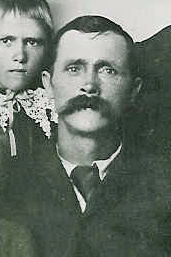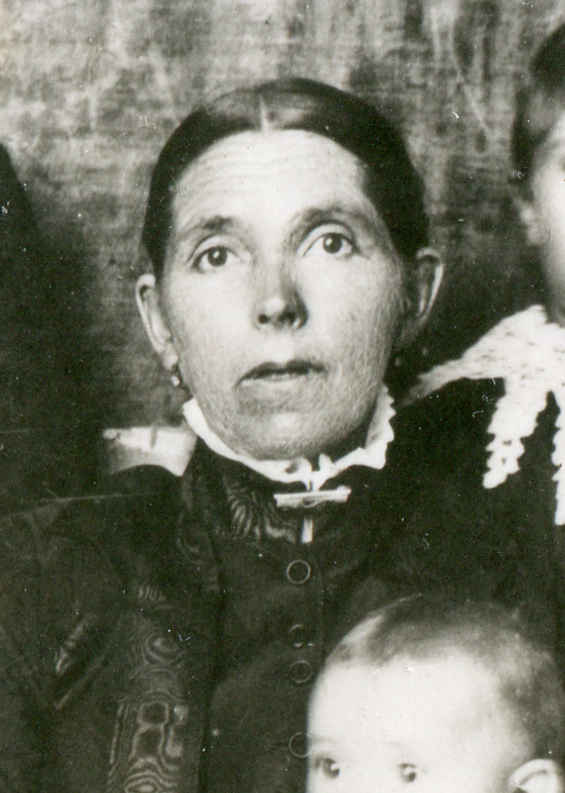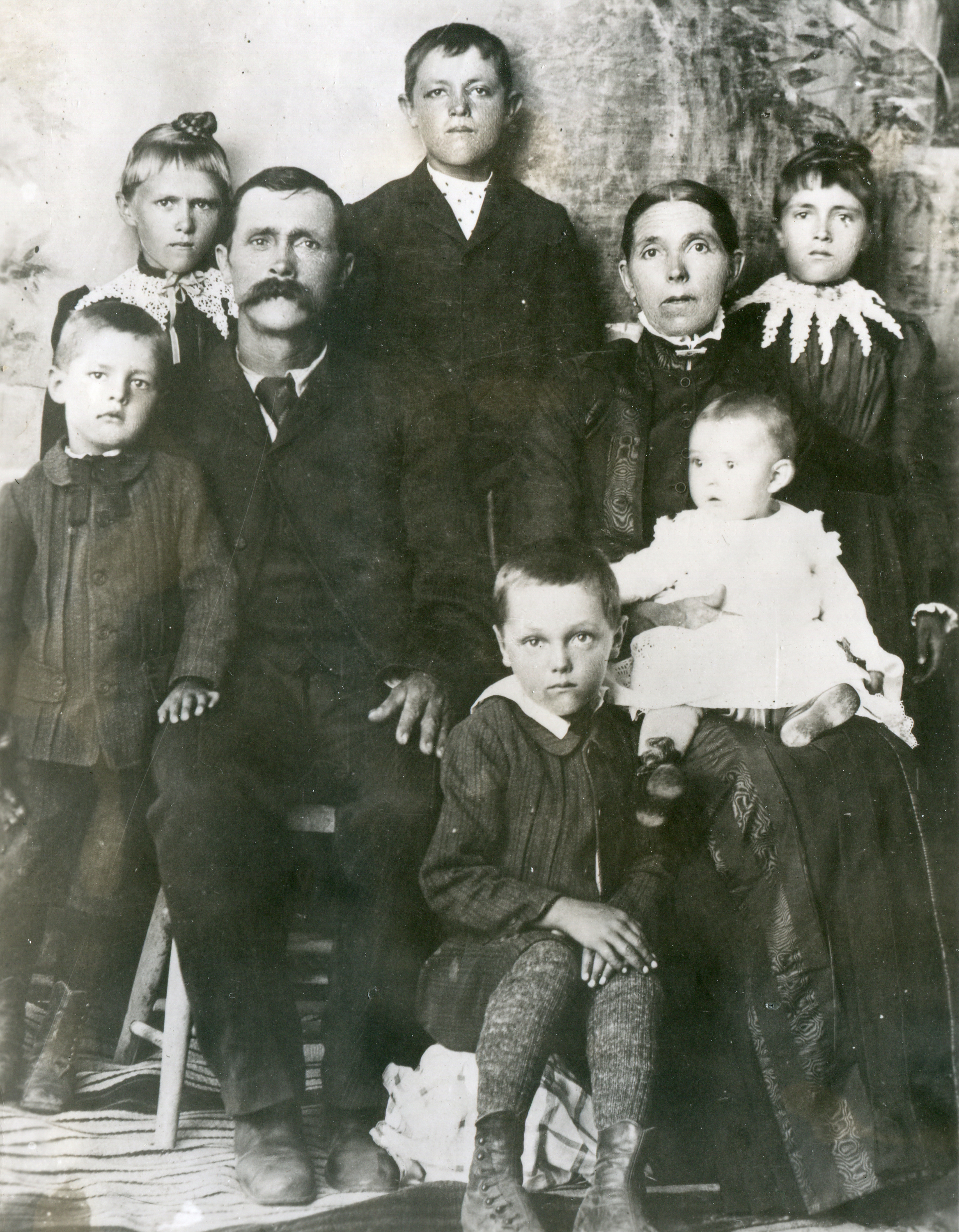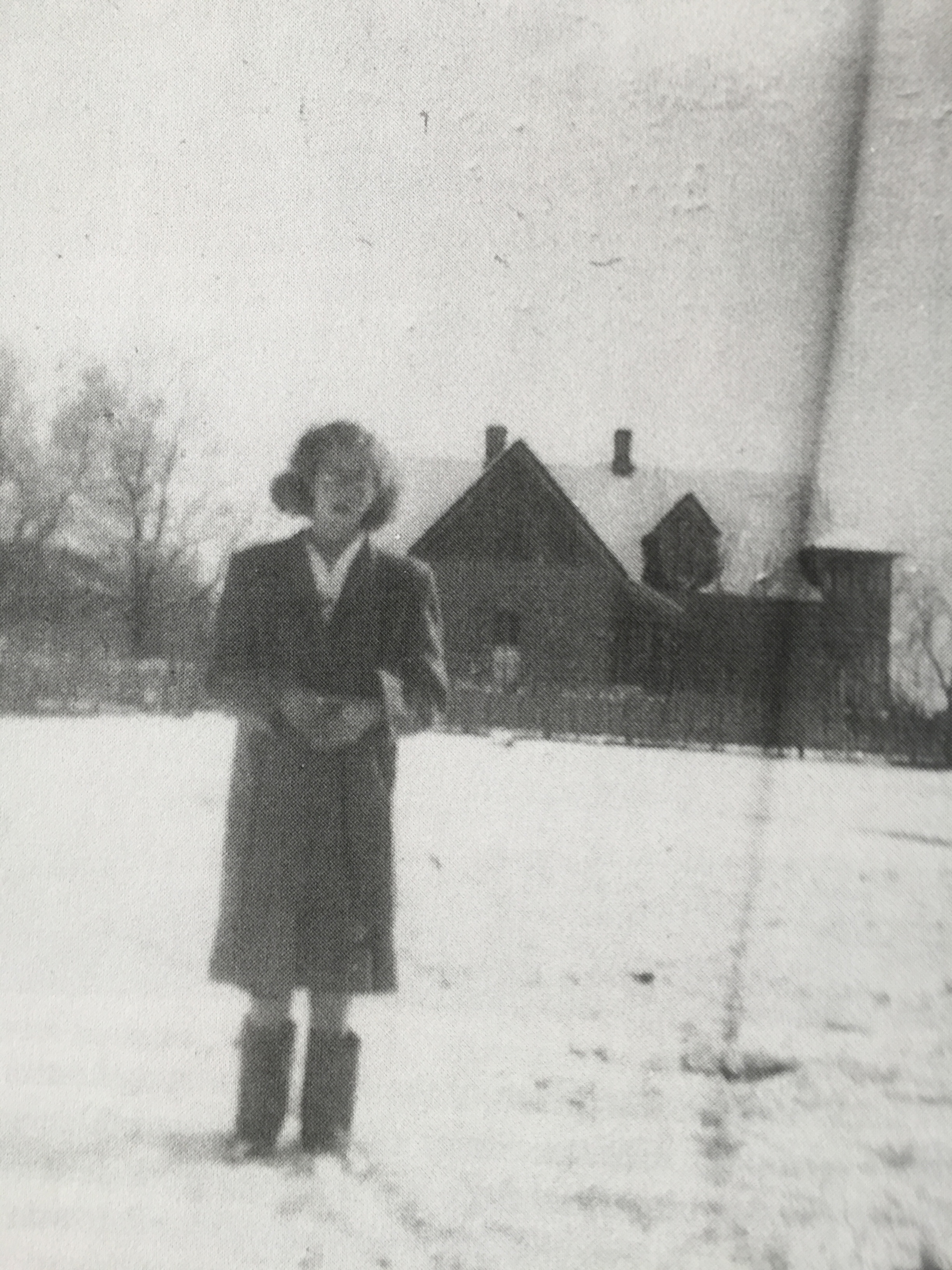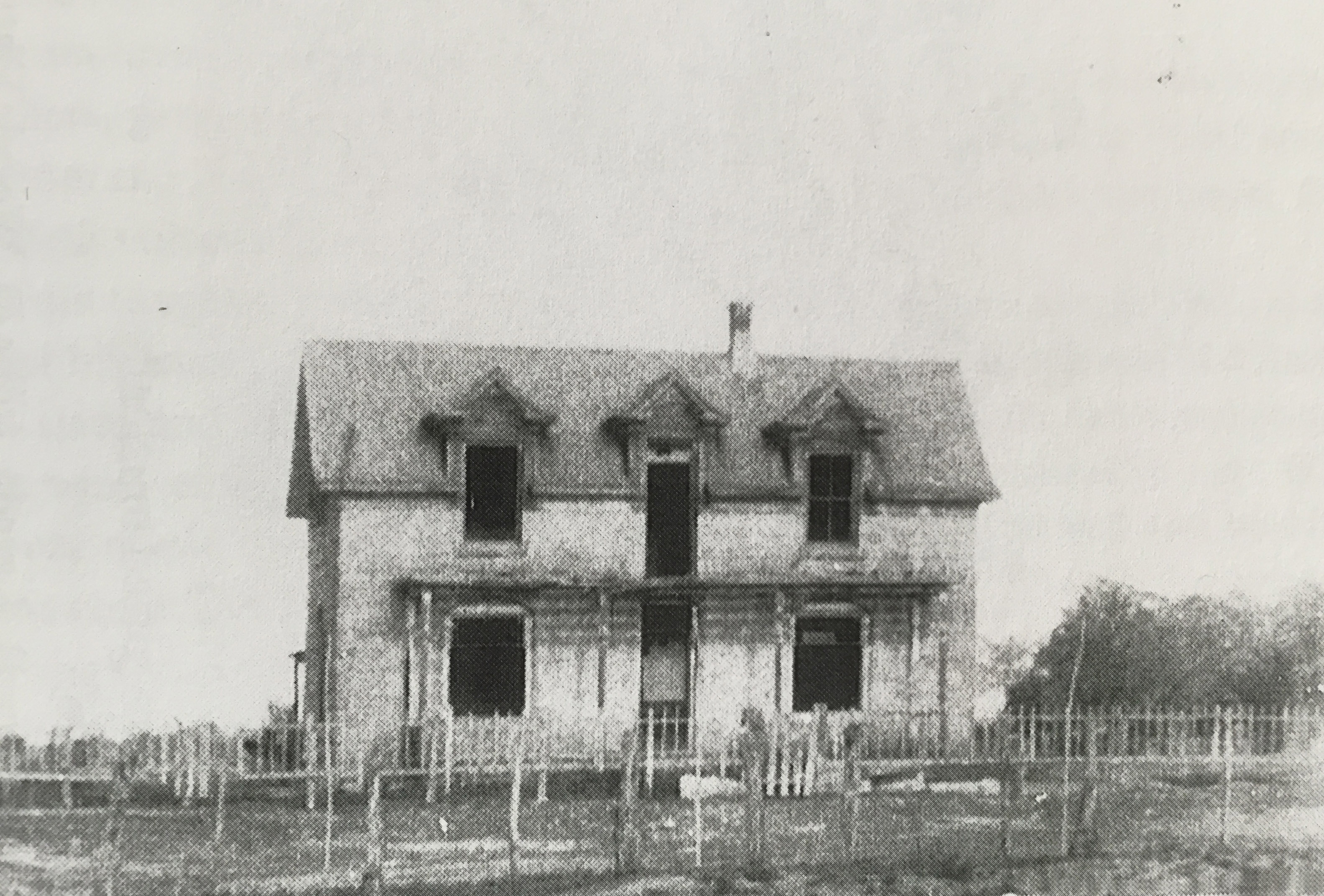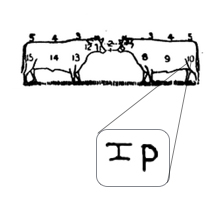History of Hyrum and Rachel Corry Perkins
Hyrum Mathews (or Hiram) Perkins
Born: 25 February 1851 at Llansamlet, Glamorganshire, Wales
Parents: William Perkins and Jane Mathews
Married: Rachel Corry, 23 April 1878 at St. George, Washington County, Utah, United States
Died: 12 March 1917 at Bluff, San Juan, Utah, United States
Rachel Maria Corry
Born: 9 February 1855 at Cedar City, Iron, Utah Territory, United States
Parents: George Corry, Jr. and Margaret Climie
Died: 26 September 1930 at Salt Lake, Salt Lake County, Utah, United States
SKETCH OF HYRUM AND RACHEL CORRY PERKINS LIVES
Several members of the Perkins family emigrated from Wales aboard he "...steamship Minnesota, with a
company of Saints numbering 534 persons for New York from Liverpool on Tuesday, June
30th, 1868 (as was a "Hiram" Perkins, who, as it turns out was "Hyrum Smith Perkins, who died
in 1874). Previous to departure, a meeting was held on the poop deck, when the Saints
were addressed by President F.[Franklin] D. Richards, upon the course which they should
pursue on their voyage. He exhorted them to faithfulness, unity, order, and brotherly love,
and promised them, on condition of observing these things, a safe and swift passage across the sea.
Elder C. [Charles] W. Penrose engaged in prayer, and dedicated the ship and the company
to the care and protection of Almighty God. Several hymns were sung, and much good
feeling was displayed. The Minnesota steamed away to sea at 4 a.m., amid the cheers and
rejoicings of the Saints on board."[*1*] (Note: The book, Pilgrims in Zion includes
a number of references to Perkins family having emigrated aboard the Minnesota in June 1867,
but on-line indexes have no references to Hyrum before 1869 and none for Ben other than 1868.)
The Perkinses on board included Benjamin and Joseph, sisters Naomi and Mary, and brother-in-
law, John Thomas Evans. After reaching New York, they had to wait a day or two before
they could board the train to the west; their destination was then Laramie, Wyoming, as the
rail line beyond that point was still under construction. Before they got off the train they
got a sight of the emigration teams waiting there for the immigrants. Four or five hundred
people were gathered around the camp indulging in a rough and rather uncouth dance. There
were no ladies participating, however, it was only a stag dance of the teamsters.
The language they used was very astonishing to us from the old country where we expected
to find the people of Zion almost perfect. If such language had been used by the church
members in Wales, they would have been required to ask the pardon of the other members.
But we soon became acquainted with their ways and shortly became one with them.
We started on West with the teams next morning. . . ."
. . . This company from Laramie City to Echo Canyon was under the direction of President
William S. Seeley. There were thirty-nine wagons and 272 souls, though four of them died
on the trip. . . . [*2*]
The Perkins brothers were met by Welsh friends in Echo Canyon and exited the train there.
They immediately found work as part of the railroad construction crew and remained in that
employment until they had sent funds for their remaining family members to emigrate. As Hyrum
is also listed with Perkins family members on their voyage, it appears that he returned to
Wales to arrange their departure. His parents, sisters, Martha and Mary, brothers, Daniel
and Dan, and Ben's fiance, Mary Ann Williams, as well as Hyrum (spelled Hyram) boarded the
same ship 'Minnesota' as he crossed on the year before. The group set sail
June 2, 1869,and arrived in Ogden the evening of June 25, being greeted by Naomi, Ben and
John Evans. They remained in the Ogden and Salt Lake area until October Conference. (Note:
Benjamin Perkins married Mary Ann Williams 4 October 1869 in the Endowment House at Salt
Lake City, and on this same date the Perkins parents were also sealed to one another there.
It appears that the parents, at least, established a temporary home in the Salt Lake City
16th ward between their arrival and October.)
Thomas Perkins, brother of Hyrum, had settled in Cedar City earlier (emigrated 1862) and now
had a small family. The larger William Perkins family decided to make their home in
Thomas' neighborhood.
Hyrum became acquainted with Rachel Corry, a young woman of English descent, whose parents
had previously emigrated to Canada, and from there to Utah in late summer 1847. After a call
to settle in Provo they continued to Cedar City where Rachel was born in 1855. Hyrum and Rachel
began courting near the time of the death Rachel's parents and of Hyrum's father, William,
in 1875. They married 23 April 1878 in St. George, and began their family in Cedar City.
Their first child, George William, was born at Cedar City 22 January 1879.
Hole-in-the-Rock expedition.
The first notification Hyrum received of his call to San Juan came at the Stake conference
at Cedar City. Hyrum's brother, Benjamin, and John Gower, a young man who was courting
Rachel Corry's sister, Harriet. They joined the company of saints from Cedar City and started
their trek the morning of 22 October 1879 and moved toward Forty Mile Spring beyond Escalante.
They were joined by other groups along the way. Hyrum's family became part of Ben Perkins'
company of ten. About half of the entire company, including the Perkins company, moved ahead
to the 'Hole.'
Their assignment at the Hole was to widen the narrow notch in the cliff so that it could
allow a wagon to travel down to the Colorado. Their mining experience in Wales, and during
the railroad construction near Ogden. Hyrum and Ben, became known as the 'Blowers and Blasters
from Wales.' They, with Jens Nielson, supervised the setting of black powder charges, which
likely included location, amount of powder, and detonation. Their crew succeeded in widening
the slit which had been too narrow for a man to pass through, to one which allowed the 80
wagons to successfully pass, albeit drop, down the first forty-five feet of cliff face.
The next barrier was about a quarter mile of road to build across a 'slantindicular' sandstone
cliff from the base of the Hole to a more gradual sandy descent to the river. This quarter
mile had to gradually move down a second forty-five foot sheer drop. Since they could not
stand on the cliff face to do their work, the men were lowered in half-barrels with ropes
to drill holes every few feet across the cliff. Into the holes were driven stakes, and
laid between stakes were layers of logs covered with brush and a fill of rock and sand,
to make a hanging dugway over the distance of the cliff. This became "Uncle Ben's Dugway."
Kumen Jones wrote years later: ...we needed men who knew how to work and were not afraid
to tackle downright hard jobs where good judgment was needed. And here is where the Perkins
Brothers. Uncle Ben and Hyrum came into the large game. The jolly good nature with which
they went at the hardest and biggest jobs was an example in psychology. It gave courage to
the less ambitious ones, and that was an asset to the cause.
Our people believe in and stand for the scripture which says, 'The song of the righteous
is a prayer unto Me and I answer it with a blessing on their heads.' Here again these two
Perkins brothers came in one hundred percent. Saying that they were good singers is just
half the story. They were willing and always in their places when needed, and they sang
with life and spirit.(Pilgrims in Zion, p. 61)
Fellow traveler, Samuel Rowley, recorded "Hyrum and Rachel came to Bluff as travelers in
the original company of colonists in the Hole-in-the-Rock expedition, during which time
they celebrated little George’s first birthday. It was a bit of a trial for his young
mother, Rachel, to keep him safely in her arms as they journeyed to Bluff. George was
eagerly learning to crawl and then to walk during the trek, and naturally wanted to test
the boundaries of his independence. But Rachel held him in her arms as best she could
while the wagons crept along over the rocky terrain. Finally they reached San Juan
County and established a home in Bluff." In another account by one of the teamsters,
Rachel was attempting to negotiate the team and wagon on her own, reins in one hand and
baby on the other arm.
Mainstays in Bluff
On April 6, 1880 the torturous travel came to an end. Their lives in Bluff, however, did
not become easy overnight. Making a home first in their wagon box, then being 'lucky'
enough to draw a number out of the hat to receive one of the limited homesites where they
would eventually build a cabin and have a garden, then see their traveling companions pull
out for places unknown, and have fear of Indian trouble see those who remained consolidate
into one block of town where actual cabins could first be constructed, more accurately
tells the story of the first weeks in Bluff. Like the other lucky ones, they had to get
their limited crops in the ground and get water to their thirsty field.
Hyrum and the other men began constructing a ditch doomed from the beginning. The land was
sandy and the source unpredictable. When they began the river was high, but would soon drop
requiring an attempt to make a dam to divert the water. They miscalculated the slope so
after the first water in the ditch would not run uphill, they had to extend it further
up river and start over. Then the sand itself either absorbed the flow or gave way to allow
the precious liquid to spill whichever way it wished. While the men labored on the ditch,
the new plants were tended with buckets carried, no doubt, by the women, or by children
under their direction.
Life did settle down for a time in the new 'fort.' More precisely a block with cabins built
along the outer edge, fireplaces facing out and all windows and doors facing inward, with
fences filling the spaces between the cabins. A log meeting house soon replaced the 'swing-
tree' for community gatherings including religious services, school, and social events.
Hyrum and many of the men also had the cattle and horses to keep track of, and keep out of
the hands of the Utes, Paiutes and Navajo. Life in Bluff would be a busy one.
By the time fall came, some 'volunteer pioneers,' those who came as helpers, but not called
to the mission, sought to go back to their former homes. Among these were Ben's brother-in-law,
Thomas Williams, and single sister-in-law, Sarah Williams, who had come along to help her
sister, Mary Ann, with the children. Sarah was one of very few in the community who were
not members of the Church of Jesus Christ of Latter-day Saints. Once in Bluff, she determined
to join their faith, and was baptized in the San Juan on 6 June 1880 a few days after her
twentieth birthday.
Rachel, who by October was seven months pregnant, did not want to deliver her new baby in
the crude circumstances at Bluff, convinced Hyrum that they should return to Cedar City to
have the baby. So, a small company, consisting of the Hyrum Perkins family, the two single
Williams young adults, and perhaps some others, headed back to Cedar City over the road
they had blazed the previous winter, promising to return to Bluff by spring. Arriving in Cedar
in late November, they were on time for Margaret Jane's birth on 11 December 1880. While in
Cedar City, Hyrum began planning the travel for another contingent of settlers to San Juan,
then took his family back across the Hole-in-the-Rock trail by early spring of 1881. The new
company did not leave Cedar City until October 1882, however.
Life in Bluff had continued in their absence -- battling the river and tenuous relations
with the Indian neighbors. On May 5, 1881, a 'fast-meeting' was interrupted by Joseph Nielson,
who had been tending the herds in Butler Wash, that trouble was at hand. Joseph had discovered
a band of Utes among Bluff's herd of horses, who, on discovery, fired on Nielson. Kumen
Jones, L. H. Redd Jr., Joseph Nielson, James B. Decker, Amasa Barton, Jess Smith,
Hyrum Perkins, George Ipson and Johhny Gower sprang into action and up Cottonwood Wash.
Crossing over into Butler Wash, they found thirty Indians, sixty squaws and papooses, a
herd of sheep and goats, and a band of 150 head of horses. The Utes came stringing down
from the rocks, and the Bluff men with L. H. Redd in lead, met them in the middle of the
valley. Eleven of the horses had been stolen from Bluff, and two of them had been gone a
year. When the Indians saw the intention of the white men to claim these horses, they
sent up a yell, and guns flashed quickly into sight. Old Baldy poked a great triggerless
rifle into Joe Nielson's face, preparing to discharge it with a stone he held in his
hand. This lumbering process gave L. H. Redd ample time to cover the old Ute with his
revolver, and when all was noise and uproar, with guns drawn on both sides, another Ute
appeared on the rock at Boiling Spring and called out loud and shrill in the Ute tongue,
"They're Mormons, let them go." The Ute band was on the run from a raid east of Blue Mountain
which left three white cowboys dead and a cabin burned.
The cry to let the Mormons go changed things "in a minute. The Utes gave up the Bluff
horses and started up the canyon. Then L. H. Redd saw a squaw on a little blue mare,
which had long been a pet in the Redd family. He ordered her off, uncinched the saddle,
removed the bridle, and left her afoot. The squaw lifted her voice and wept, in fact she
lifted it as high as possible, hoping by her lofty notes to bring the retreating warriors
of her people; her husband ordered to cry more and louder. It was no use" for the Utes had
developed "a superstitious fear of shedding Mormon blood." (AR Lyman, History of San Juan)
As a rule, the Bluff settlers sought peace with their neighbors, and fed them rather than
fighting them. That attitude allowed not only cattle or horses to be stolen ... for "[what]
they stole from these peaceful Mormons was the easiest gain the Indians had ever known,
and some of them became fearful lest the remainder of their nation would discover the snap
before they got their share. Even the squaws and papooses visiting town were not there
for their health or their curiosity only.
"One Navajo squaw, bent on making her trip pay, took a pair of baby shoes from the home
of Hyrum Perkins. He had been watching her movements, and missed the shoes soon after her
departure, but she had made straight for the river and gone across. Getting an interpreter,
he followed her to her hogan, and asked her for the shoes. The accusation was a terrible
shock to her dignity and honor as an honest woman. When he convinced her he knew she had
taken the shoes, she admitted she had picked them up, but declared she put them on the end
of a log standing out from the corner of the cabin, describing the exact place with great
detail and wonderful hyprocracy. In spite of her protests and threats, they proceeded to
search the hogan, moving sacks, sheepskins, saddles and blankets, but no shoes were
uncovered. Then they moved the Navajo lady herself from the seat she had occupied
continuously since their arrival, and there were the shoes. She broke into a loud laugh,
and seemed to regard it as a huge joke on them."
(History of San Juan, AR Lyman)
In September 1881, two white strangers appeared in town seeking to trade horses. When no
deal could be reached, they rode off. A few days later, it was discovered that the Bluff
herd had disappeared. After a search, tracks were found, and a "council was held and of
the few men in town. Bishop Nielson selected L.H.Redd, Hyrum Perkins and Joseph A. Lyman
to follow the tracks of the stolen horses. The pursuit took days and the two thieves were
found at Hall's Crossing on the Colorado River. After the thieves and contraband had
crossed the river, knowledge of the trail gave the Bluff posse the advantage, and they
recaptured their horses, and those of the crooks, and headed back towards the crossing
while the thieves lay in ambush unaware at first that they had been outsmarted. Hyrum and
the Hall brothers herded the reacquired herd across the river while Redd and Lyman guarded
their rear. Then, taking a rowboat Redd and Lyman attempted to cross the river under rifle
fire from the two strangers. In the process, Lyman was seriously wounded, leg shattered by
a bullet. Lyman could not ride. Redd remained with him and Hyrum began the long ride back
toward Bluff for aid.
A Navajo named Pahlilly came across Redd and Lyman and provided assistance in the form of
the location of a water source and a poultice made of prickly-pear, offering some
relief. Hyrum, meanwhile, met Mrs. Thales Haskel, George Hobbs and others, going back in
a light wagon to the settlements, who then hurried along to the shadscale bench,
arriving there October 5th. The wounded man had lain three nights on his blankets without
his wound having been dressed. Mrs. Haskel being an excellent nurse, proceeded at once to
attend this matter, after which he was placed in the wagon, his leg in a wooden trough the
Halls had made, and they started slowly away for Bluff. Joseph, "Jody," Lyman survived,
but was crippled, and lived until 1925 having a large posterity.
In October 1881, Benjamin Perkins returned to Cedar City with the intent of taking Mary Ann's
sister, Sarah, be his second wife. Sarah would remain in Cedar on some land on Cedar Mountain
which belonged to the Williams family, and Ben begins a life with two families, but not often
in the same house. Mary Ann returned to Bluff for a year or so.
It is clear that the road back west had a fair amount of traffic, for again on March 10,
1882, John Gower, Hyrum's brother-in-law, was found to be nearly dead with consumption,
Hyrum took him by wagon to Cedar City. The trip through hundred and seventy-five miles of
wilderness was made successfully, and he lived three more years in Cedar.
When the Co-operative was organized, in April 1882, Hyrum was back in Bluff and became
one of the directors and Ben the treasurer. Later in 1882, Hyrum is listed as a trail
guide bringing more settlers to Bluff. Feeling the Mission to San Juan would be closed,
Ben sold his cattle to Hyrum and moved Sarah to Bluff and Mary Ann to Cedar City. Hyrum
became a prominent cattleman, and founder of the Bluff Cattle Pool.
He was a part of the Elk Mountain exploring party which established grazing rights west of
current Blanding, and participated in the buying-out of the Colorado cattlemen. Hyrum
became a member of the San Juan Stake High Council in the Mormon Church. Like her
husband, Rachel was a hardworking woman, obedient to the calls the Church made upon her
and her family. She was a friend to the Indians and gained their confidence. She was
active in the Bluff Ward and served there in the Primary presidency when it first began.
Through the years of effort to establish and maintain the ditch. Albert R Lyman stated:
"No history of the Bluff ditch should progress far without mentioning Hyrum Perkins; not
only because he traveled on the trot and never tired, but because he grew into the
workings of that ditch as a vital part of it, and was the heart which propelled its life
blood, twenty-five years later. The hopeful plans of 1880, which contemplated twenty
miles of farms along the river, simmered down to the Bluff ditch, and even that was too
much. At best it watered only seven hundred acres, and the number soon dwindled to
three hundred."
The population also dwindled with families feeling freed from the Mission obligation, and
establishment of Monticello, Blanding, and more distant communities. Soon, only ten families
remained. "Dances and friendly gatherings in the old log hall lost Samuel Cox and his dear
old fiddle, and C. E. Walton had gone with his horn to settle at Blue Mountain (Monticello).
Sometimes Thales Haskel made music for the dance with an accordion, and sometimes the
music came only from a harmonica, accompanied by an organ. If harmonica and accordion
were not there, Hyrum Perkins could sing quadrilles and waltzes like a phonograph. In
spite of their homliness, and in spite of their lack of any fastidious culture, the
doings in the old log hall held a dignity and sacredness which admitted of no rude invasion." (A.R. Lyman)
During the early 1890s the cattle business became a financial success, and sandstone homes
began to replace the log cabins. Both Hyrum and Rachel believed in education, and their
nine children (George, Margaret, Rachel, Hyrum Corey, Daniel, Frank, Hugh, Janet, and
Joseph Earl) attended college at Brigham Young University (BYU) in Provo, Utah. A gold rush
along the San Juan brought many prospectors but no glitter to Bluff. Rachel opened her home
to take in boarders. Then oil was discovered in the region, and another boom came to town.
"Rachel was an immaculate housekeeper but she couldn't keep sand from their food, bedding,
and what furniture she had. The women lined their ceilings and walls with a material they
called 'factory.' It was an unbleached muslin that they bought by the bolt. Each time it
rained the material became stained from the soil that was used on the roofs and had to
be taken down and washed...Rachel made her own mattresses and quilts from wool she had
washed and corded. She made her own butter and in the spring when milk was plentiful
she made cheese. The bread she made was excellent and she was known in the community as
being an accomplished cook and housekeeper. She saved every scrap of fat that came her
way, strained the melted fat through cheese cloth, and made her own soap... (Pilgrims, p65)
Rachel insisted that her husband and sons come to the table, set with linens, in a white
shirt, even though they made their living on the land -- a habit she learned in Cedar City
and one she shared with her brothers.(Pilgrims, p. 94) She was late to the assembly at the
time of Amasa Barton's being shot. "She explained that there were bits and pieces of tidying
that she had to do in her house before leaving it and even in the face of marauding Navajos
her standards would prevail. (Pilgrims, p. 79)
Ben returned to settle in Monticello with Mary Ann, and Sarah in Bluff. Both he and Hyrum
ran freight wagons between the towns in the region. At first supplies came from
Alamosa, Colorado, and after the railroad was built into Durango they could get what they
wanted there. Ben and Hyrum's brother, John , who lived in Mancos, talked with Ben about
setting up a general store. The plan did not develop because of the success of the Bluff
Co-op store...
On freighting trip back from Durango, Hyrum was thrown from the wagon, and thought to be dead.
He said his spirit did leave his body, and he was given the choice of remaining in the spirit
world or remain living. He told his family there were two things that he wanted to do
before he left for good, and came back to see that they were done. (Pilgrims p 77)
The freighting business required long and monotonous traveling. On these trips he found himself
with hours of idle daylight. He would carve dolls from wood for his little girls, as well
as other little girls in Bluff. "Most every little girl had one or more of Uncle Hy's dolls."
(Pilgrims, p. 77)
Often, all ten of the remaining men were off freighting, or tending herds, leaving the
women and children developed a sturdy self-assertiveness, and a wholesome faith in the
protecting hand of Providence and Bishop Nielson alone.(Chapter XXXV History of San Juan)
True to Bluff, Hyrum died there on March 12, 1917, from cardiovascular disease. He was buried
in Bluff. Rachel outlived him by thirteen years. She died at a daughter's home in Salt Lake
City 29 September 1930. But, due to rumor of a dam across the San Juan, she was laid to
rest in Blanding.
Sources:
1 'Minnesota' Voyage Notes
2 1936 Sketch by A R Lyman
3 Tennity, Margaret P, Pilgrims in Zion..., Shumway Publishing, 1998.
4 Bluff, Utah Website
George William Perkins story, HIRF.org

